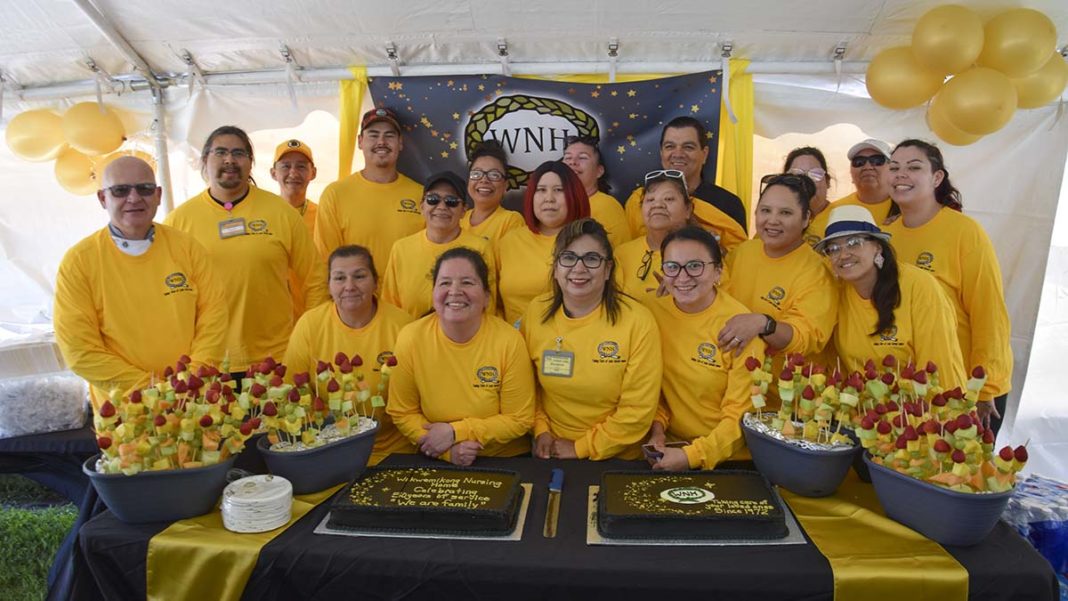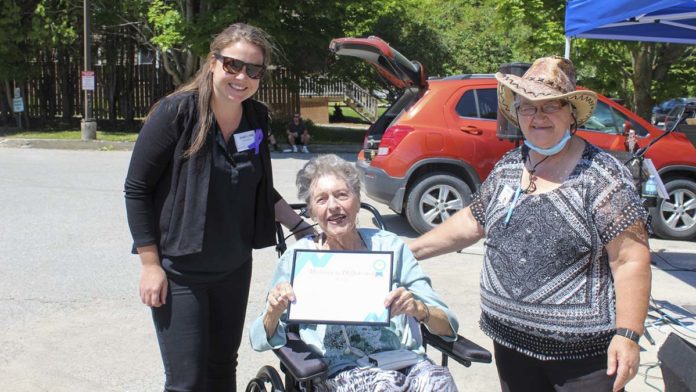WIIKWEMKOONG—Gizhinaamde joined in the festivities for ‘We are Family,’ the 50th anniversary celebration of the Wiikwemkoong Nursing Home (WNH) on Friday, June 17, but thanks to some very well-emplaced iron pegs, the large canopy set up over seating for residents, family and friends stayed put for all the wind’s flapping protest.
The windy day did absolutely nothing to dampen the mood, however, as WNH residents were joined by the community in celebrating the half-century milestone. One of the high points of the day was a walking parade by school children from nearby Pontiac and Wiikwemkoong Junior schools who marched by waving signs, ringing bells and waving.
The ceremonies began with a prayer by Dorothy Wassegijig-Kennedy and a welcome song performed on the hand drum by brothers Jesse and Adam Kaboni, before Wiikwemkoong Ogimaa Duke Peltier delivered remarks and congratulations on behalf of chief and council.
Ogimaa Peltier relayed the many positive comments he has heard about the staff, food and activities that have become legendary, not only in the Wiikwemkoong communities, but across all of Manitoulin and the province beyond. “Especially from the family and community members,” he said. “And the cooks, the cooks are some of the best around.”
“It was the vision of many of our council members and community leaders back in the mid-60s that envisioned to have a home in the community—they set forward on that vision and put a plan in place. Some of the council members envisioned that some of them might live here in the future.” Ogimaa Peltier noted his grandfather volunteered his equipment to lay the foundations and infrastructure for the home. In later years, his grandfather came to live at WNH and was very happy to be living there. “He didn’t want to go out to visit anymore,” said Ogimaa Peltier. “That is a testament to this residence.”
WNH history speaks to what a dedicated servant of the community can accomplish. It was then Wiikwemkoong welfare administrator Boniface George who took the reins and accomplished something of a first for a First Nation community.
In 1968 a number of elders from Wiikwemkoong were about to be discharged from hospital, but there was nowhere suitable for them to go, as the elders had significant daily health and living needs. In those days there were no social workers as we know of today, or local health staff, so Mr. George took it upon himself to find a solution.
That solution came in the form of the old Murray Hill school building. Following light renovations, a pair of housekeepers were retained and the half-dozen residents of what we now call a group home were settled in. There was no funding for staff for such a facility in the late ‘60s and early ‘70s, but a little creative effort by Mr. George and his colleagues resulted in volunteers and paid staff being put in place.
In the absence of a staff nurse, arrangements were made to have the community health resource and clinic nurses pop in to check on medications and perform light treatments.
Within a few months the ad hoc arrangement proved so successful that other folks began applying for lodging and the process was repeated with the old elementary school/convent. By 1969 Wiikwemkoong had a 12-bed group home.
But the waiting list began to swell, with inquiries coming in from other area First Nations. Two main types of applicants were soon identified, those with chronic illnesses that needed regular nursing care and others that were living in very substandard conditions—most without running water or indoor plumbing. It was clearly time for a full-blown nursing home. But, of course, there was no funding from Indian Affairs available for such a facility.
Nursing homes were private businesses back in the day, and getting a loan to start such a business was nigh onto impossible for First Nations—largely due to the reluctance of financial institutions to front the money with a lack of assignable assets.
But thanks to perseverance, and a whole lot of determined lobbying, in 1971 a 50-year $250,000 mortgage was secured through Canada Housing and Mortgage Corporation, a first for a First Nation community.
But there was no resting on laurels for the community, as the mortgage only covered the construction costs. There was still the matter of furnishing the facility. What followed was a scramble of fundraising and scrounging of discarded hospital beds and other equipment from health centres from Manitoulin to southern Ontario. That original 30-bed facility was filled in no time, and a second 12-bed facility was built in 1978 for those just needing a roof over their heads. In 1980 a further 30-bed extension was added to WNH, this time with financing from the Bank of Montreal.
Ogimaa Peltier noted that a new residence for the community is in the works and that fundraising is well underway. “In a few short years we hope to have you moving into that new home,” he said.
“Chi-miigwetch for coming today,” said Cheryl Osawabine-Peltier, WNH administrator. Ms. Osawabine-Peltier reiterated the words of Ogimaa Peltier, noting that WNH has a reputation for having the best food, the best care and the best activities on the Island. “That is a huge testament to all of the staff,” she said, pointing to the staff who were wearing yellow T-shirts. “We continue to embark on great things.”
Ms. Osawabine-Peltier explained that the home’s licence expires in June 2025 and that the current building does not meet standards. “So, we applied to Ministry of Health and Long-term Care for a new facility and received approval for a new 96-bed home,” she said. “The new home will be more of a home than an institution.”
Algoma-Manitoulin MPP Mike Mantha greeted the assembly and said how eager he is to step through the doors of a new facility. “None of this is possible without their help,” he said, referencing the staff, chief and council and community before reading a joint statement from himself and Algoma-Manitoulin-Kapuskasing MP Carol Hughes wishing great success in the years to come.
WNH resident James (Jett) Francis has garnered a fair measure of fame thanks to his many media interviews over the last couple of years on behalf of WNH and as a bingo caller for the residents and he spoke at length about how comfortable and engaging the WNH community is, especially when it comes to fun and games. The WNH social media feeds are filled with hilarity and laughter as testament to his talk.
Mr. Francis referenced WNH’s oldest resident, Elizabeth Debassige of M’Chigeeng, who has reached the century mark, noting that at 100, Ms. Debassige took part in a recent watersliding event. Ms. Debassige was in attendance at the 50th with granddaughter Robin and great-grandchild Jase. “I’m the second-oldest,” asserted Ms. Debassige with a smile.
A cake-cutting followed along with photographs before those in attendance joined in a light lunch and listened to the musical stylings of Robbie Shawana and friends fiddler Doug Hore, bassist Urban Mejaki, keyboardist Maurice Labelle and drummer Daniel Wassengeso.





